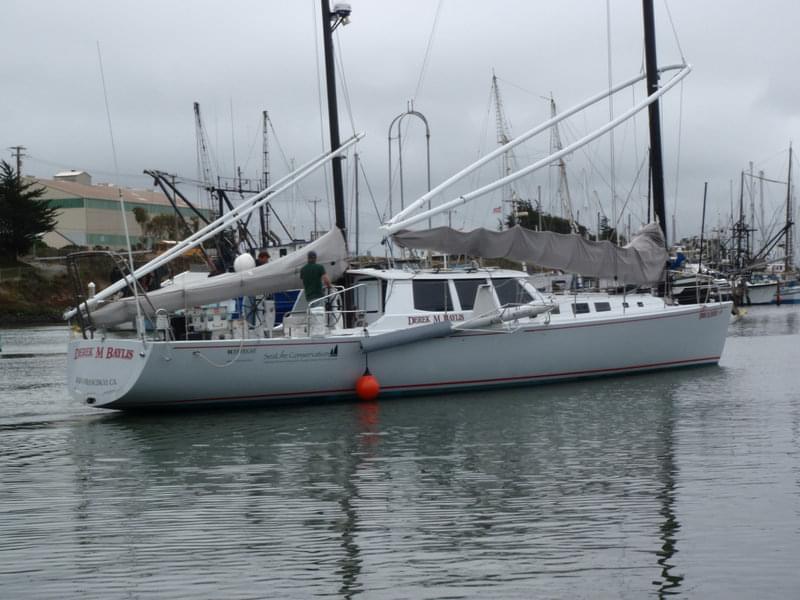
By Chris Goldfinger - Marine Geologist/Geophysicist - Oregon State University, Marine Geology Active Tectonics Group,
and Waldo Wakefield - Research Fisheries Biologist - NOAA Northwest Fisheries Science Center
One unique aspect of the San Andreas Fault 2010 expedition is that the geophysical science legs of the ship-borne operations will be conducted from the Sailing Research Vessel (SRV) Derek M. Baylis (DMB), a state-of-the-art vessel designed as a prototype for the ‘green’ research vessels of the future. DMB is a 65-foot auxiliary-powered sailing research vessel, cat-ketch rigged with tapered free standing carbon fiber masts, and a light composite, easily driven hull that is extremely fuel efficient under power—using less fuel than most cars! It also has the advantages of being acoustically quiet, low impact in terms of bubbles that interfere with the ships sensors, and nearly free of pollutants. DMB has a rear deck like a trawler, living quarters forward, and uses wind as its primary fuel. In every respect, the DMB is purpose-built to provide a comfortable, fast and eco-friendly vessel for research and education.

The Derek M. Baylis heads to sea for the transit to Fort Bragg. Image courtesy of San Andreas Fault 2010 Expedition, NOAA-OER. Download image (jpg, 130 KB).
Though the construction requires overcoming unique design challenges, operating an eco-friendly ship such as the DMB offers distinct advantages over conventionally powered research platforms. The DMB can travel quietly, economically and emit zero pollution, making it specially suited for non-obtrusive monitoring. The low radiated noise of the Baylis will improve data quality from the acoustical sensing systems. Added stability from the auxiliary sails will reduce the motion corrections (mostly roll compensation) needed for multibeam echosounder data, also improving data quality. We have planned the operations as for a normal vessel under power, but hope to use sail power in specific areas when weather permits.

Derek M. Baylis images clockwise from upper left: ROV monitoring in the pilothouse/science workspace; Derek M. Baylis general view; Deploying gear from the open transom stern and A-frame; WHOI glider under the A-frame. Image courtesy of San Andreas Fault 2010 Expedition, NOAA-OER. Download image (jpg, 119 KB).
In addition to the mapping and imaging the fault, part of this exploration is dedicated to testing these data-gathering technologies under the low-power, high-efficiency operation of the DMB. The economical power consumption of the Baylis will allow 24 days of sea time within a very modest budget. DMB carries up to 24 passengers comfortably on day trips and 10 passengers all-oceans. The large cargo capacity, transom, stern mounted titanium A-frame, and 22-foot long aft deck facilitate easy deployment of a wide range of gear. The Baylis has a 6 kw AC generator and cruises at 10 knots under power, using only 2 gph of diesel fuel.
The multibeam echosounder will be deployed from a pole mount to starboard The DMB has a titanium A-Frame with 7’9” clearance and capacity to handle AUV/small ROV’s at the stern with its removable transom, with monitoring of all operations in the pilothouse/science workspace. For the current project, the A-Frame will serve multiple purposes as a davit, installation site for a host of GPS and heading sensors, and gallows for deploying “streamers“ – a key element of the seismic reflection acoustical system.
Regardless of the geological and biological findings of the expedition, scientists will have gained valuable experience working from the environmentally friendly Derek M. Baylis, setting a precedent for the advantages and feasibility of ‘greener’ practices in ocean exploration.